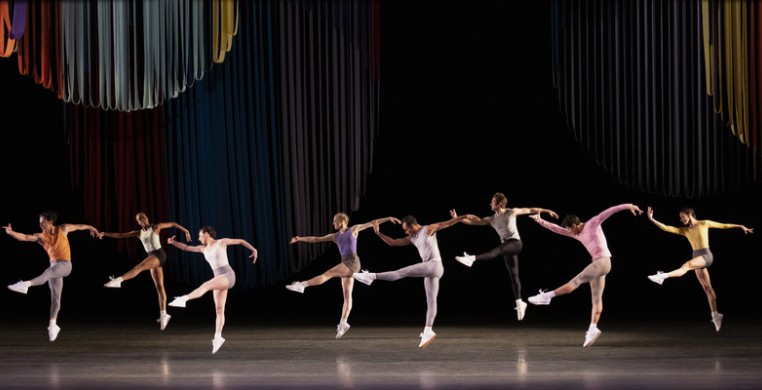Established institutions struggle with how to stay fresh and current without losing their signature identity. New York City Ballet (NYCB) combats outdatedness by hiring celebrated contemporary choreographers while staying true to the philosophy of its founder, George Balanchine, who said: “If you don’t feel challenged, it’s because you’re not doing enough. Ballet should never be comfortable.”
NYCB’s ability to keep up with the times is on display in “21st Century Choreography,” presented at Harris Theater March 22-23. The program featured some of today’s most popular choreographers—Justin Peck, Christopher Wheeldon, Pam Tanowitz and Kyle Abraham—and a repertoire of some of their best-known work.
Peck’s “Partita” (2022), a “sneaker ballet” that replaces ballet slippers with white shoes, outright defies ballet conventions. Like Balanchine, Peck creates fantastic visual elements, e.g. a mass of bodies unraveling like a flower blooming in slow motion. Unlike Balanchine, these elements have a transmutable quality, rarely static and constantly changing. Adding to the aesthetic appeal are large, colorful discs suspended overhead, like moons of a distant planet, their light feeding the alien growths appearing on stage.
The choice of music adds to the surrealistic atmosphere. Short, contrasting tracks of layered a capella vocal music, composed by Caroline Shaw and performed by Roomful of Teeth, range from guttural growls to a swooping “oooh” and a blaring dissonant “ahhhh,” reflected in the dance through shifting vignettes of solos, duets, small and large groups. Dancers rise then fall and expand then contract in time and timbre to eerie soundtrack. Despite the otherworldly feel of the work, the unencumbered movement and sneaker-clad dancers impart familiarity, like being at a raucous neighborhood dance party.
In contrast, Wheeldon’s “Liturgy” (2003), a duet performed by Unity Phelan and Chun Wai Chan, feels more human and presents a story of companionship. Chan, dressed in red, is the more assertive; Phelan, wearing frosty blue, more docile. Phrases ending in sweeping, prolonged lifts suddenly freeze. From there they rewind their movements, reset and begin a new scene, like a relationship being rewound on videotape.
A high-pitched violin solo by Kurt Nikkanen builds the action to a fever pitch, with Chan launching Phelan several times into the wings, only for her to bound back like a boomerang, a recognizable sign of lovers who can’t get enough of each other, but whose relationship is ultimately doomed.
A pleasant contrast in the program is Tanowitz’s “Gustave Le Gray No.1” (2019), with music by Shaw for solo piano, performed by Stephen Gosling, and featuring vibrant red, robe-like costumes designed by Reid Bartelme and Harriet Jung.
The work rejects popular narratives about what contemporary dance should look like. Long, repetitive passages of thigh slapping, cakewalking and comedic pizzicato foot taps elicit chuckles from the audience. Gosling accompanies the dancers on stage, and belly laughs erupt as they push the piano across the length of the floor—with Gosling still playing! Many patrons may not associate modern dance with comedy, but they should, and Tanowitz’s work serves as a reminder of the depths achievable through modern dance.
It’s not all humor-based. “Gustave Le Gray No.1” is a light yet meditative study on creating pleasing visual forms on stage through recapitulated phrases of movement that use the radiant costumes to superb effect, with chuckles as a cherry on top.
 Pam Tanowitz's "Gustave Le Gray No.1" with Stephen Gosling (Solo Pianist), Naomi Corti, and Adrian Danchig-Waring; Photo by Erin Baiano
Pam Tanowitz's "Gustave Le Gray No.1" with Stephen Gosling (Solo Pianist), Naomi Corti, and Adrian Danchig-Waring; Photo by Erin Baiano
Abraham’s “Love Letter (on shuffle)” is like going in and out of a dream where punk rockers, wearing costumes resembling Elizabethan-era nobles crossed with the angular clothing worn in the cartoon “The Jetsons,” and their friends, Aztec emperors wearing feathered headdresses, take over a nightclub for a wild, trap music-infused dance party.
Dancer Taylor Stanley shines as the ostensible protagonist, the white ruff around his neck flowing as he leaps into an assemblé with arms waving like a bird’s wings, beginning a flight that takes us through a series of short scenes punctuated by blackouts. Solos, duos, a jaunty group quadrille, dancers in a circle playing an aggressive game of duck, duck goose…
Scenes shift rapidly, but the dancing stays consistent. Diamond-edge lines in the quick-moving bodies break during moments of personality—a cheeky smile and shoulder shimmy, the pulsing of isolated body parts, fluttering toes that match tripping syllables in the music by James Blake.
As the party on stage winds down, a recorded voice pleads, “Don’t walk away in sadness…”
We didn’t. Instead, the audience stood and erupted in applause, showing joy for the company’s triumphant return to Chicago. In “21st Century Choreography,” NYCB has managed to maintain its identity as one of the world’s leading ballet companies while putting a new spin on Balanchine's revolutionary transformation of classical ballet into an innovative art form.

